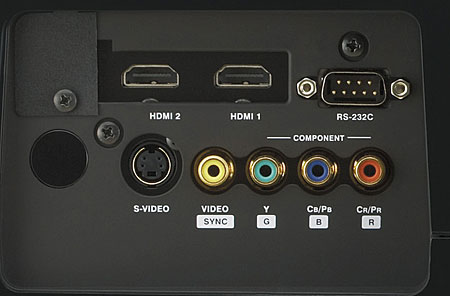JVC DLA-HD100 D-ILA Projector Setup & Tests
I placed the HD100 on my usual projector shelf, about 12 feet from my 78-inch-wide, 16:9 Stewart Studiotek 130 screen. That put the projector at roughly the midpoint of the lens' zoom range.
Unlike the manual zoom and focus of the HD1, the HD100's zoom and focus controls are motorized, and they can only be adjusted using one of the projector's several internal test patterns, not an external source. When I lined up the internal pattern with the borders of the screen and returned to real program material, the image size did not quite match the screen.

The difference was small, but to correct it, I had to slightly overcompensate in the adjustment, drop out of the menu, check the result, then repeat the process until the fit was correct on real programming. This was a minor annoyance, but it's not something you'll have to do often—an argument that could, of course, be made against the need for a motorized zoom in the first place!
 The video adjustments are global across all inputs—you can't set in different values for different inputs. But you can establish different Image Profiles, each with different settings, for different inputs. The six available Image Profiles (Cinema, Natural, Dynamic, User 1, 2, 3) can all be individually configured.
The video adjustments are global across all inputs—you can't set in different values for different inputs. But you can establish different Image Profiles, each with different settings, for different inputs. The six available Image Profiles (Cinema, Natural, Dynamic, User 1, 2, 3) can all be individually configured.
There are five Color Temp selections: Low, Middle, High, User 1, and User 2. Both User settings provide separate overall red, green, and blue adjustments. In addition, there are red, green, and blue offset controls that helped me to dial in the grayscale.
If you lack sophisticated test tools and the expertise to use them, I don't recommend tweaking the JVC's flexible gamma adjustments much beyond the presets, which should provide an appropriate gamma setting for most sources. You might find that different programs need different settings, but for me, Normal worked fine most of the time. A skilled calibrator can use the red, green, and blue gamma controls to further tweak the grayscale, if not early on, then perhaps later as the lamp's color balance starts to change with age.
Once I tweaked the Pixel Adjust slightly from its out-of-box settings, all three primary colors were closely converged in the center of the image but just a bit off at the edges (less than one pixel). A difference in convergence in different parts of the screen is not generally due to panel misalignment but rather to chromatic aberration in the lens, and in my case, it was small enough that it wasn't an issue on normal program material. The JVC was neither better nor worse in this regard than any other projector I've tested in or near its price range.
The HD100's deinterlacing and scaling via HDMI was fair, at best, in upconverting a 480i input to the display's native 1080p. It failed some of my standard tests for jagged edges from the HQV Benchmark DVD. Oddly, it performed much better on these tests with a component video input. Fortunately, 480i HDMI sources are becoming increasingly scarce, so this shouldn't be much of a problem.
The JVC correctly deinterlaced 1080i (both film and video) to 1080p. It turned in a mixed result recognizing 3:2 pulldown on some of my test discs, but it sailed through the difficult passages in Mission: Impossible III, with no moiré on the bricks of the Vatican walls in chapter 7 or the pan across the steps at the beginning of chapter 8.























































